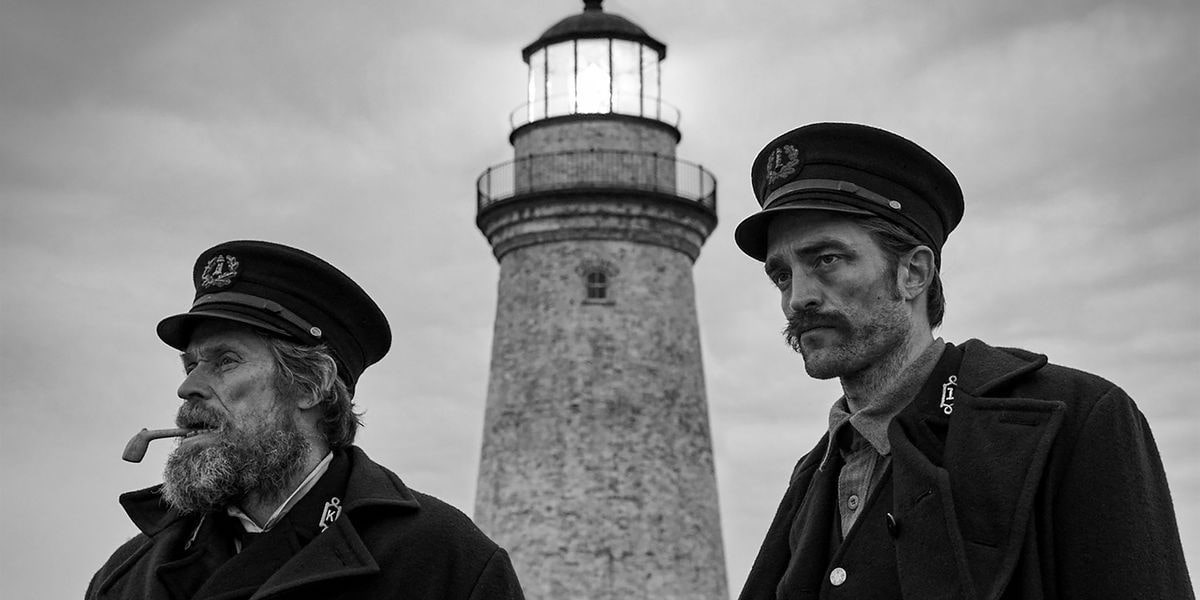The Lighthouse is Robert Eggers' newest film, after the 18th century psychological horror masterpiece movie The VVitch. This film too is a meticulously put together work of art, with a fabulous dual cast of Willem Dafoe and Robert Pattinson (trivia: this is the first time I saw a movie with Pattinson), bombastic dialogues, great visuals and the best Lovecraftian atmosphere I’ve seen in a long time.
The premise of the movie is simple: two men have to maintain the lighthouse together for four weeks. Of course, lighthouse keeper isn’t a job that attracts so-called ‘normal people’, so our two characters are at odds with each other and the only thing they have in common initially is their facial hair. The old man is grumpy, shows a weird possessiveness about the light in the tower and likes to pull rank as the senior ‘wickie’ (the nickname for lighthouse keepers) on the barren island and keeps giving young Pattinson’s character lot’s of tiresome chores to do. The young man is the silent type, seemingly carrying a troublesome past. This leads to a few conflicts between the two men during their stay on the desolate rock. But when at the end of their mission the weather turns from bad to worse, the two men descend into drink and into madness.
The whole film bathes in a bleak atmosphere of loneliness, confusion and despondency. Each character has their own way of dealing with the situation. Dafoe is great in portraying the estranged mariner with a somewhat crazed look in his eyes when he starts rambling. Pattinson on the other hand is best when he’s repressing his anger, and although the weird hallucinogenic scenes are great, he’s somewhat less convincing as a maniacal desperate.
While this is a horror movie in the classical sense, it’s not bereft of humor. There are lots of small moments and scenes that lighten to otherwise bleak mood. Willem Dafoe farting regularly certainly makes it difficult to experience even a movie this grim as depressing. But it’s more than just toilet humor; many of the interactions between the two men, especially when drunk, become amusing and confusing; and there are absurd moments that elicit laughter from some type of people that include myself.
Another area to mention is sound. The ominous sounding foghorn (that warns ships during the day), the rattling noise of the steam engine powering the horn, and the ever present sounds of the water: splashing waves, pattering rain (real rain, by the way, not staged) making the work more miserable, the dripping of water inside the house. And the accents and language are great too: Dafoe speaks in archaic mariner tongue, using lively seaman’s expressions, while Pattinson is a much simpler man, speaking in a landlubbers dialect.
And keeping the best for last: the cinematography is superb. The movie was shot on 35mm black and white film (more specifically Kodak Double-X 5222 film), with old lenses and cyan filters, and shot in an almost rectangular (1.19:1) format used in some old movies. This combines to give the movie a gritty, claustrophobic look. But Eggers makes beautiful use of its restrictions (and thus its possibilities). There are both high-contrast scenes that convey the highly dramatic tension, as low contrast scenes that help to establish the lonely, abandoned mood, such as the ship appearing (and disappearing) in the mist. There’s even a scene where the manipulation of the film is used, by means of (pseudo-)solarization.
Robert Eggers is making his name as a preeminent director of quality horror these days, and I’m curious about what he’ll make for us in the future. Be sure to give this one a viewing, it’s worth it.

Willem Dafoe and Robert Pattinson as the gruffy lighthouse keepers